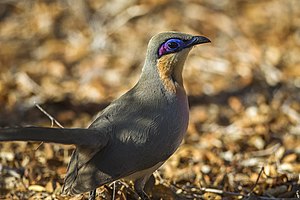Yellow-throated silk cuckoo
| Yellow-throated silk cuckoo | ||||||||||||
|---|---|---|---|---|---|---|---|---|---|---|---|---|

Yellow-throated Cuckoo ( Coua cursor ) |
||||||||||||
| Systematics | ||||||||||||
|
||||||||||||
| Scientific name | ||||||||||||
| Coua cursor | ||||||||||||
| Grandidier , 1867 |
The yellow-throated silk cuckoo ( Coua cursor ), also called yellow-throated cuckoo , is a species of bird from the genus of the silk cuckoo ( Coua ) endemic to the island of Madagascar . The species occurs exclusively in the south and southwest of the island. It is a medium-sized, strongly built, long-legged and long-tailed cuckoo that lives mostly on the ground. Like all other species of Couas, the red breasted silky cuckoo does not brood paratism, but rather raises its offspring itself.
No subspecies are distinguished for this type of cuckoo. However, the species is closely related to the red breasted silk cuckoo , which occurs in northeastern Madagascar. The IUCN classifies the yellow-breasted silk cuckoo in the category not endangered ( least concern ).
features
The yellow-throated silkworm reaches a body length of 34 to 40 centimeters and a weight of about 118 grams. The wing length averages 13.3 centimeters. The beak has an average length of 2.5 centimeters. The tail plumage measures between 18.2 and 20 centimeters. There is no noticeable gender dimorphism .
The top of the body and the wings are pale gray to olive green, the tail is a bit darker gray without shades of blue. In contrast to the giant silk cuckoo and the Coquerel silk cuckoo , the underside is white, the throat yellow-brown and the chest slightly purple. The beak, the legs, which are shorter than that of the white-throated silk cuckoo, and the feet are black. The face is black. The iris is surrounded by a blue eye ring. The bare skin around the eyes, framed by black feathers, is blue with a large pink area in the back third. This border is still missing in the young animals.
Possible confusion
There are several other types of cuckoo in the distribution area of the yellow-throated silk cuckoo, with which it can be confused. The giant silk cuckoo is significantly larger than the yellow-throated silk cuckoo and is paler on the upper side of the body. It also has a partly reddish underside of the body that the yellow-throated silk cuckoo lacks. The orange-red underside of the body also distinguishes the Coquerel silk cuckoo from the yellow-throated silk cuckoo. The white-throated silk cuckoo , on the other hand, has a different facial coloring.
distribution and habitat
The yellow-throated silky cuckoo lives in the southwest of Madagascar in tropical and subtropical dry forest , thorn-bush savannahs , thorn forests (spiny forest) and open areas with limited ground vegetation.
Way of life
The yellow-throated silkworm looks for insects on the ground and usually moves around continuously. He is true to location.
Reproduction
The breeding season is in October during the rainy season, chicks can be seen in February and March. The bowl-shaped nest about 2 m high consists of twigs and bark.
literature
- Johannes Erhitzøe, Clive F. Mann, Frederik P. Brammer, Richard A. Fuller: Cuckoos of the World . Christopher Helm, London 2012, ISBN 978-0-7136-6034-0 .
Web links
Individual evidence
- ↑ Avibase Coua cursor
- ↑ Erhitzøe, Mann, Brammer, Fuller: Cuckoos of the World . P. 212.
- ↑ Handbook of the Birds of the World on the Gelbkehl-Seidenkuckuck , accessed on October 21, 2017
- ↑ Coua cursor in the IUCN 2016-3 Red List of Endangered Species . Posted by: BirdLife International, 2016. Retrieved October 21, 2017.
- ↑ a b c d Handbook of the Birds of the World
- ^ A b F. Hawkins, R. Safford, A. Skerrett: Birds of Mdagascar and the Indian Ocean Islands. Helm Field Guides, 2015, ISBN 978-1-4729-2409-4
